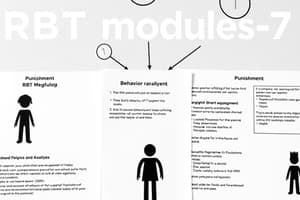Podcast
Questions and Answers
What is one essential component of a written behavior reduction plan?
What is one essential component of a written behavior reduction plan?
- Crisis intervention strategies
- A list of all medications
- Supervisory feedback protocols
- A clearly defined target behavior (correct)
Which of the following is an example of differential reinforcement?
Which of the following is an example of differential reinforcement?
- Ignoring all negative behaviors
- Punishing a child for making mistakes
- Rewarding a child for using appropriate language instead of yelling (correct)
- Providing a timeout for disruptive behavior
What is the primary purpose of implementing extinction procedures?
What is the primary purpose of implementing extinction procedures?
- To increase the likelihood of positive behaviors
- To eliminate a behavior by removing its reinforcement (correct)
- To reduce the intensity of all behaviors
- To provide immediate feedback to clients
Which factor is important to report in a timely manner to ensure client care?
Which factor is important to report in a timely manner to ensure client care?
What are RBTs required to maintain as part of their professional conduct?
What are RBTs required to maintain as part of their professional conduct?
What is the primary purpose of the RBT Task List?
What is the primary purpose of the RBT Task List?
Which task falls under the Measurement content area of the RBT Task List?
Which task falls under the Measurement content area of the RBT Task List?
What does C-10 refer to in the context of Skill Acquisition?
What does C-10 refer to in the context of Skill Acquisition?
Which of the following procedures is part of the Skill Acquisition content area?
Which of the following procedures is part of the Skill Acquisition content area?
Which task requires a behavior technician to assist with individual assessment methods?
Which task requires a behavior technician to assist with individual assessment methods?
What is a characteristic of both continuous and discontinuous measurement procedures?
What is a characteristic of both continuous and discontinuous measurement procedures?
Which task involves identifying key components of a written skill acquisition plan?
Which task involves identifying key components of a written skill acquisition plan?
What does the acronym RBT stand for?
What does the acronym RBT stand for?
Flashcards
Behavior Reduction Plan Components
Behavior Reduction Plan Components
The essential parts of a plan to decrease challenging behaviors.
Behavior Functions
Behavior Functions
Reasons why a person engages in a specific behavior.
Antecedent Modifications
Antecedent Modifications
Changing events before a behavior to reduce it.
Differential Reinforcement
Differential Reinforcement
Signup and view all the flashcards
Session notes, objective data
Session notes, objective data
Signup and view all the flashcards
RBT Task List
RBT Task List
Signup and view all the flashcards
Continuous Measurement
Continuous Measurement
Signup and view all the flashcards
Discontinuous Measurement
Discontinuous Measurement
Signup and view all the flashcards
Preference Assessment
Preference Assessment
Signup and view all the flashcards
Skill Acquisition Plan
Skill Acquisition Plan
Signup and view all the flashcards
Discrete Trial Teaching
Discrete Trial Teaching
Signup and view all the flashcards
Naturalistic Teaching
Naturalistic Teaching
Signup and view all the flashcards
Functional Assessment
Functional Assessment
Signup and view all the flashcards
Study Notes
RBT® Task List (2nd ed.)
- The Registered Behavior Technician™ (RBT®) Task List details common tasks performed by RBTs.
- A supervisor determines additional tasks the RBT is competent to perform.
- The list is a basis for RBT training and the RBT examination.
- Primary content areas include Measurement, Assessment, Skill Acquisition, Behavior Reduction, Documentation and Reporting, and Professional Conduct and Scope of Practice.
A. Measurement
- A-1: Preparing for data collection.
- A-2: Implementing continuous measurement procedures (e.g., frequency, duration).
- A-3: Implementing discontinuous measurement procedures (e.g., partial interval, whole interval, momentary time sampling).
- A-4: Implementing permanent product recording procedures.
- A-5: Entering data and updating graphs.
- A-6: Describing behavior and environment in observable and measurable terms.
B. Assessment
- B-1: Conducting preference assessments.
- B-2: Assisting with individualized assessment procedures (e.g., curriculum-based, developmental, social skills).
- B-3: Assisting with functional assessment procedures.
C. Skill Acquisition
- C-1: Identifying essential components of a skill acquisition plan.
- C-2: Preparing for the session according to the plan.
- C-3: Using contingencies of reinforcement (e.g., conditioned/unconditioned, continuous/intermittent schedules).
- C-4: Implementing naturalistic teaching procedures (e.g., incidental teaching).
- C-5: Implementing task-analyzed chaining procedures.
- C-6: Implementing discrimination training.
- C-7: Implementing discrete-trial teaching procedures.
- C-8: Implementing stimulus control transfer procedures.
- C-9: Implementing prompt and prompt fading procedures.
- C-10: Implementing generalization and maintenance procedures.
- C-11: Implementing shaping procedures.
- C-12: Implementing token economy procedures.
D. Behavior Reduction
- D-1: Identifying essential components of a behavior reduction plan.
- D-2: Describing common functions of behavior.
- D-3: Implementing interventions based on antecedent modification (e.g., motivating operations, discriminative stimuli).
- D-4: Implementing differential reinforcement procedures (e.g., DRA, DRO).
- D-5: Implementing extinction procedures.
- D-6: Implementing crisis/emergency procedures.
E. Documentation and Reporting
- E-1: Effectively communicating with a supervisor.
- E-2: Actively seeking clinical direction from a supervisor.
- E-3: Reporting other factors affecting the client.
- E-4: Generating objective session notes.
- E-5: Adhering to legal, regulatory, and workplace data requirements.
F. Professional Conduct and Scope of Practice
- F-1: Describing BACB RBT supervision requirements and role.
- F-2: Responding appropriately to feedback.
- F-3: Communicating with stakeholders (e.g., family, caregivers).
- F-4: Maintaining professional boundaries.
- F-5: Maintaining client dignity.
Studying That Suits You
Use AI to generate personalized quizzes and flashcards to suit your learning preferences.




